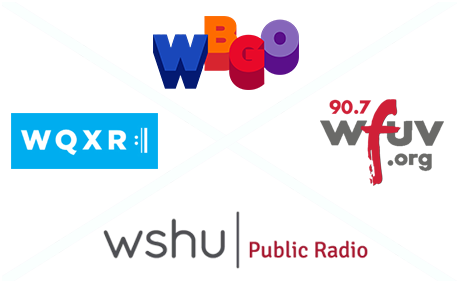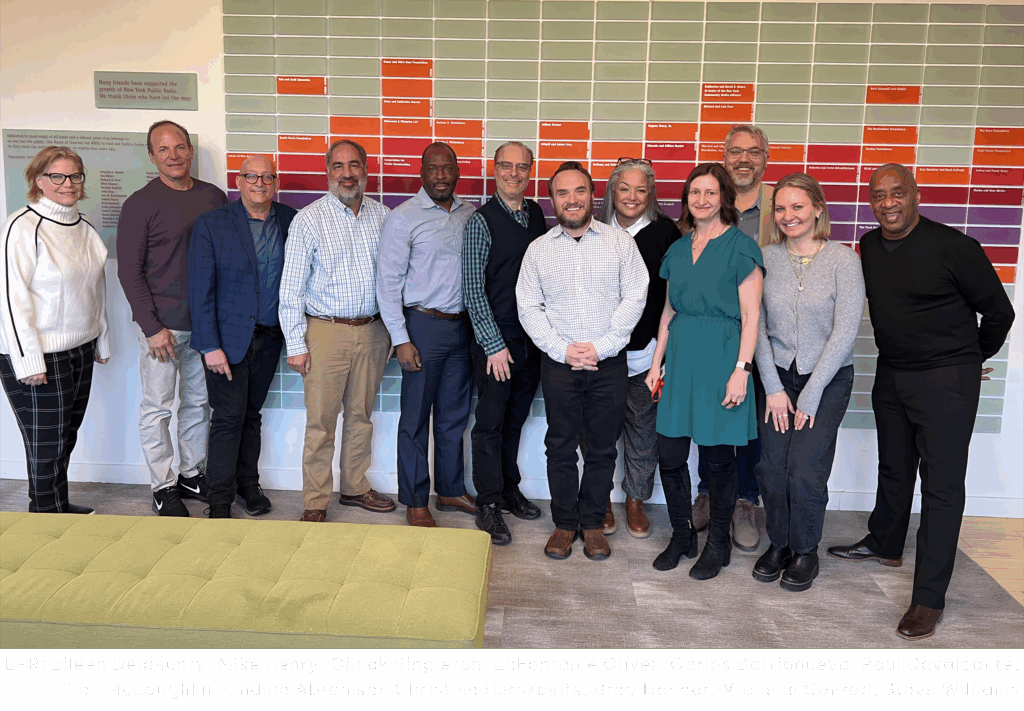
Public radio’s first-ever collaboration of four independently owned stations is a glimpse into the future of public media. Defunding public media has thrust the concept of shared content, events, and internal services to the front burner. Four stations in the New York City area – Jazz WBGO, Triple A WFUV, and Classical WQXR (NYC) and WSHU (Connecticut) – have spent the past year peeling the onion to find ways to work together. With funding from the Corporation For Public Broadcasting (CPB) and consulting from Public Media Company (PMC) and Paragon, the stations have shed their competitive spirit to find common ground.
Serving Music Audiences Through Station Partnerships
Last week at the Content Conference staged by Abby Goldstein and the Public Media Content Collective, the Tri-State Public Radio Music Station collaboration was on full display. WQXR Interim General Manager Eileen Delahunty and WFUV Program Director joined me on stage to share the results of CPB’s pilot grant.
Why did the stations decide to collaborate in the first place?
- The four stations understood that rising tides lift all boats. With audiences and revenue declining and changes in music consumption, they decided they are stronger working together.
Was it difficult to share confidential strategies, data, and internal planning?
-
 I was amazed at how quickly the managers opened their playbooks and shared competitive information.
I was amazed at how quickly the managers opened their playbooks and shared competitive information. - Paragon had previously conducted audience research for WBGO and WFUV, and both stations shared their findings with the group.
- Membership data was shared and analyzed by Contributor Development Partnership (CDP) to identify opportunities for enhanced fundraising performance and subgroups (i.e. members who support multiple stations) to target with different messaging and support coordinated new member initiatives.
What type of new research was conducted?
- Paragon conducted Membership Studies for all four stations to identify member patterns, habits, and preferences that can now be weaved together to improve each station’s member acquisition and joint member acquisition campaigns.
- We also provided Digital Audits for the four stations to help each fortify all digital platforms and to create new digital touchpoints between them.
How did the four stations communicate?
- PMC facilitated the entire process, which included bi-weekly calls and tracking all topics, conversations, and agreements. All of us attended a kick-off meeting in New York where much of the final outcomes were decided. The commitment level was impressive considering the unusual demands on their time during the defunding process.
What did they decide to do together?
- They decided the imperative was to grow audience by expanding the listening pie, identifying common ground with their digital platforms, and most importantly, by using joint events that create audience awareness, community engagement, and trust within the collaborative stations.
- The stations created a Big Tent strategy based on bringing the other stations into what had been single-station events, creating new shared events, sharing event and venue contacts, and amazingly, sharing event sponsorship contacts for the good of all.
What lessons were learned that other stations can leverage?
- Overcoming mistrust
- Finding a shared vision
- Hit singles not home runs
- Events are the common bond
Defunding occurred after the grant was underway. How did that alter their plans?
- Shared content and internal services suddenly became more important.
- WBGO picked up “New Standards with Paul Cavalconte” from WNYC. Calvalconte also hosts “Calvalcade” on WFUV.
- WFUV host of “The Whole Wide World,” Delphine Blue, now has a show on WBGO, “Delphine’s Delights.”
- The stations are continuing discussions about sharing internal services, including production and broadcast operations including board operators, traffic, finance, and promotion resources.
What were unintended benefits?
- Open Knowledge Sharing
- The four stations opened their playbooks for all stations to learn from
- Cooperation
- Cultivated a “cooperation over competition” mindset
- Event Production Transparency
- Generous with information sharing about events: partnerships, costs, planning for staff, etc.
- Strategic Support During Crisis
- Opportunity to share internal and fundraising strategies while de-funding occurred after the grant was underway
- Programming Cross-Pollination
- An unexpected program sharing agreement was also formed outside the collaborative between WBGO and Long Island’s WLIW. After Labor Day, WLIW’s evening music show, “Urban Jazz Experience,” will debut on WBGO, and WBGO’s “Singer’s Unlimited” with will air on WLIW.
What’s next for this collaboration?
The grand plan concept is to launch an events app that would be custom branded (not branded with station names) and promoted separately by each station. The events would be curated by all four stations to include each of their own events and other events aligned with their audience’s lifestyle. Each station would create an on-air daily events calendar that would only promote their events and point listeners to the app for a detailed listing of all local events. The calendar would be embedded on their websites and pushed out through their socials. Even in market number one, there are no curated events calendars (only pay-for-play and heavy pop-up ads), so this is an unmet need. The app and all promotion points are ripe for sponsorship. I believe the shared public media app is a concept that other stations should strongly consider for their market.
More about Mike.
Miss the conference? Watch the session here.

Leave A Comment